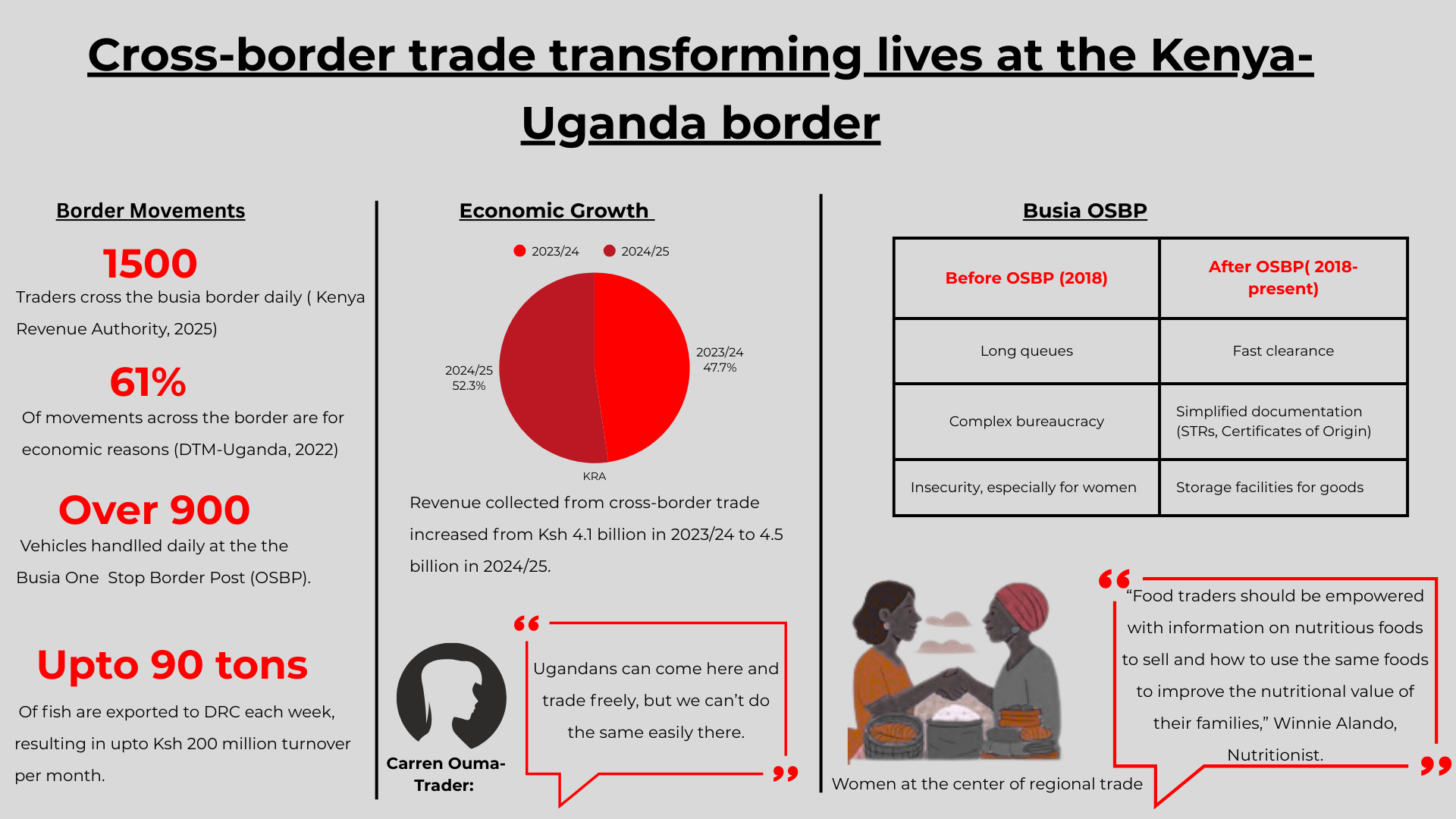
Busia is one of East Africa’s busiest border crossings. It comes alive in the wee hours with the rustle of sacks and the clamour of early buyers haggling prices.
A group of women carefully arranges piles of onions and tomatoes, while nearby, others sort massive bunches of bananas.
The rich foodstuffs appear fresh and just from the farm, signalling the huge abundance of nutritious foods flowing through from Uganda into Kenya through the border town.
The Kenyan Busia market, however, is just one part of the story. Like Siamese twins, Busia Uganda located just a walk across the border features a similar scene as a thriving cross border trade holds the spine of this small microeconomy, breathing life to nutrition.
On both sides, only a few flags dotted in some premises remind you that they are two separate countries divided by an invisible border line but thriving on unity of a population unbothered by boundaries.
Residents say the two markets are the spine holding the region’s food security, and the source of meals for families in the region and its environs.
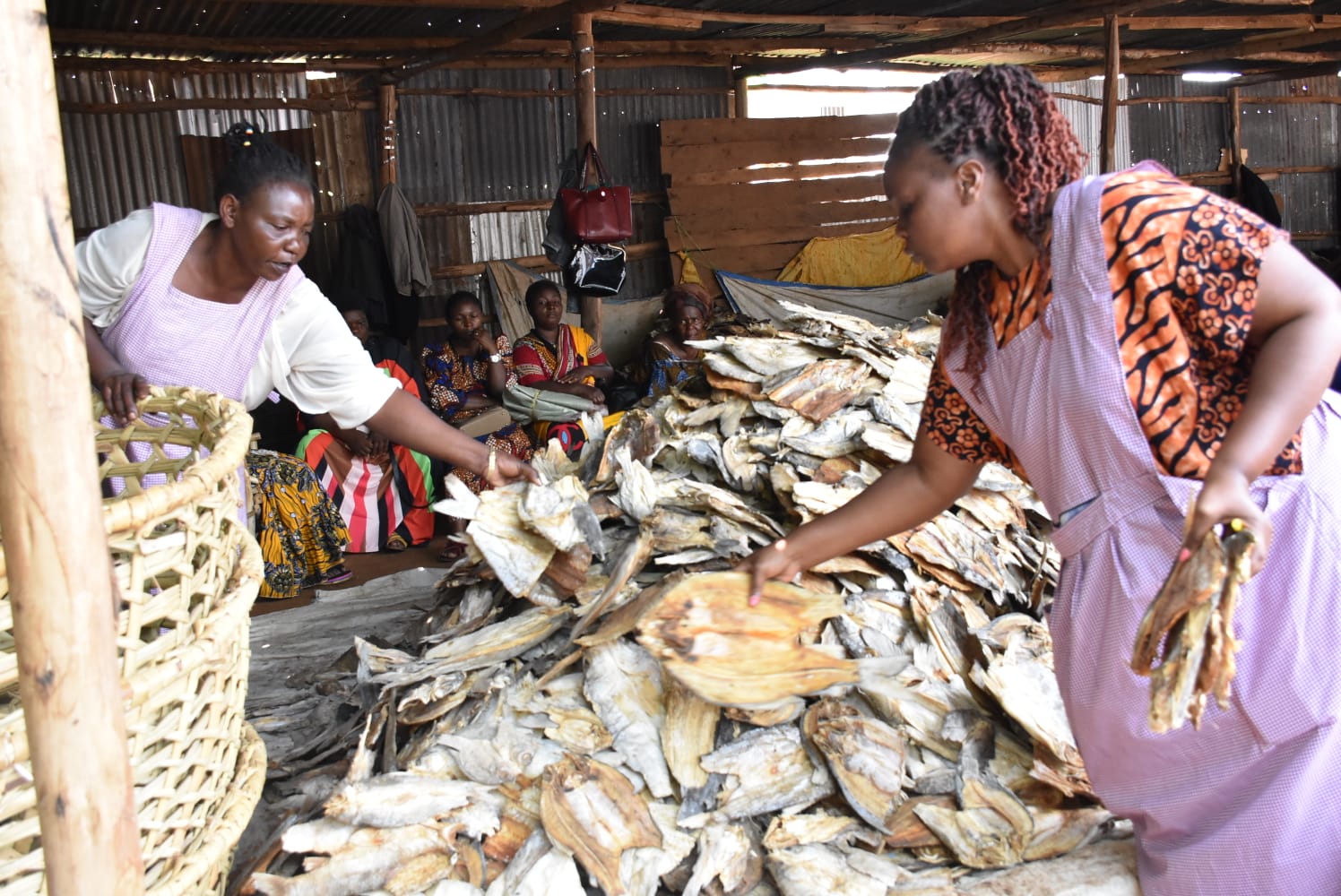
FACES BEHIND TRADE
On the Kenyan side, we find Jennifer Naguts, a Ugandan trader from Maero village, busy flipping a ward of Ugandan and Kenyan notes.
A few minutes earlier, she had been at her home in Maero village in Uganda, where she collected the bananas, ready to sell to her Kenyan customers.
“I bring bananas from home and sell them here every day,” she says with a smile, adding that people buy with whatever currency they have.
She spends USh4,000 (KSh150) on transport daily and pays Sh50 in market fees.
Jennifer is among hundreds of Ugandan women selling foodstuffs in Kenya daily as a result of a seamless cross-border trade that is exploiting East Africa’s free movement of goods and people.
“We are one big family,” she says. “I source foodstuffs from Uganda and sell them in Kenya daily. We have embraced each other well and it is very common to see customers buying goods with either Kenyan or Ugandan currency.”
Although she joined the cross-border trade 10 years ago, she shifted to selling foodstuffs because of the high demand from Kenya.
Initially, she would sell household goods. Today, she says, it is a joy to participate in supplying nutritious meals to Kenyan families and earning a small income in return.
What warms her soul most is being able to contribute to the country’s nutritional needs.
“I am a mother and I know how important the foods we sell are to the people, especially young children,” she says.
A few metres away from where she sits to sell her bananas, a long row of women selling various foodstuffs is busy calling for customers. Their wares include onions, tomatoes, green vegetables, eggs and cereals.
Most of the women are Ugandan migrants, who are the mainstay at the market and are at the heart of food supply for thousands of households in Kenya.
Mary Namboso and Jalat Akumu, who are also busy sorting out their foodstuffs, say business is thriving and is promising to transform economic fortunes for many families.
“The currency value in Kenya is higher,” she says, adding that this makes it easier to meet their daily needs, especially school fees.
Being able to improve the country’s nutritional needs is something she values.
Every evening, she also buys sun-dried fish from Kenya to take home to her children.
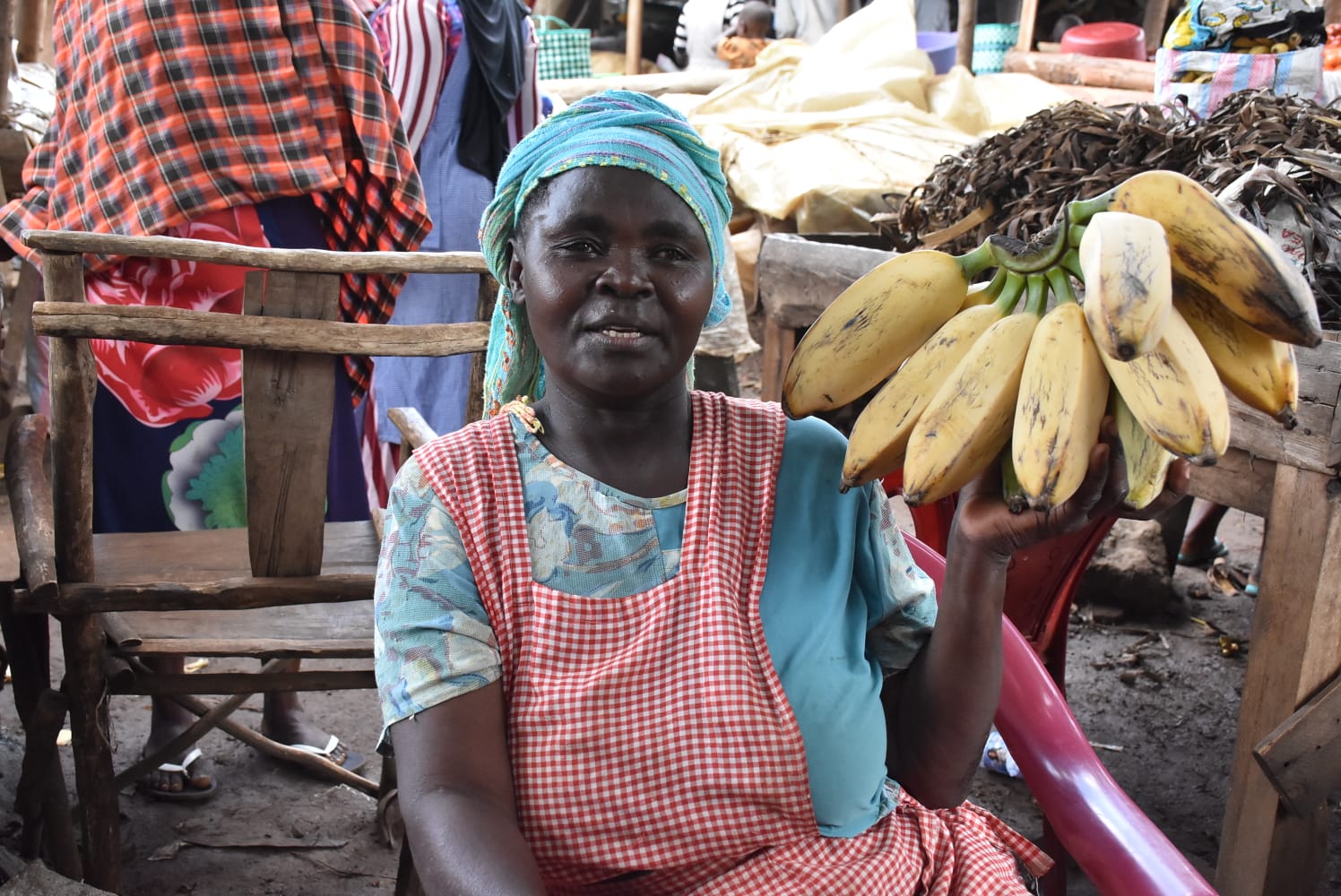
NUTRITIONAL MISSION
The trade these women conduct goes beyond economics; it's about food security, feeding families and communities’ nourishment.
Caren Ouma, a 43-year-old Kenyan trader who sells dried fish, underscores this point.
For 25 years, she has run her business at the Busia Fish Market, now employing 10 people.
They sell sun-dried fish from Lake Turkana to Uganda and even to DRC. They first grade the fish before it.
“I started young. Initially my parents were doing this business and that's where I learnt from them. I have educated my children and one has completed university,” Caren says
Nutritionist Winnie Alando highlights the impact this trade has had on regional diets, saying the food crossing the border — bananas, tomatoes and fish — is essential to fighting malnutrition.
“Fish provides high-quality proteins and Omega 3 fats,” Winnie said.
“Tomatoes and bananas offer essential vitamins, potassium and fibre. These foods improve immunity and organ health.”
The cross-border market ensures food is easily available and the communities can easily access it and mostly, it's always foods that the other community doesn't have; it's like barter trading.
“The community that produce tomatoes in excess will sell to the side that has a scarcity. This also helps in availing a variety of foods that communities can choose from that impact dietary diversity,” Winnie said.
“The women are helping to improve food security because of creating the availability of these foods. The challenge might me the costing because this is business and profits must be made.”
She adds that regional trade can help address malnutrition or micronutrient deficiencies by looking at affordable foods that can be easily traded and made accessible to communities, and also trade foods with high nutritive value, not just foods.
The Busia Ministry of Agriculture and that of Health say more than 60 per cent of the Busia population is suffering from chronic food insecurity and poor nutrition.
Meanwhile, 31 per cent of children below the age of five are malnourished, and 26.5 per cent of children under the age of five are stunted.
Busia county nutrition coordinator Scholastic Nabade says the county has been grappling with various forms of malnutrition, including under-nutrition, overnutrition and micro-nutrient deficiencies.
With the huge influx of traders from Uganda migrating to the region and the vibrant trade on foodstuffs that has gained root in the border town, hopes are high that malnutrition will be a thing of the past.
TRADE SUPPORT SYSTEMS
Statistics from Kenya Revenue Authority indicate that an average of 1,500 traders cross the official border point every day to access the Kenyan market. Most cross with foodstuffs.
So thriving is the business that the government has already collected KSh4.5 billion in revenues between July last year and April this year. The figure is an increment from the Ksh4.1 billion that was registered the previous year.
“Since the establishment of the Busia One Stop Border Post [in 2018], KRA has observed a steady increase in cross-border trade volumes from Uganda to Kenya,” KRA said in a statement.
The One-Stop Border Post serves as a model for streamlined border procedures between Kenya and Uganda, demonstrating significant improvements in trade efficiency and women’s economic empowerment.
Before its establishment, traders endured long clearance queues and complex bureaucratic procedures, with women particularly vulnerable to security risks and lacking storage facilities for unsold goods.
Today, simplified trade regimes (STRs), certificates of origin and other accessible documentation have replaced lengthy procedures, allowing women to manage their transactions independently.
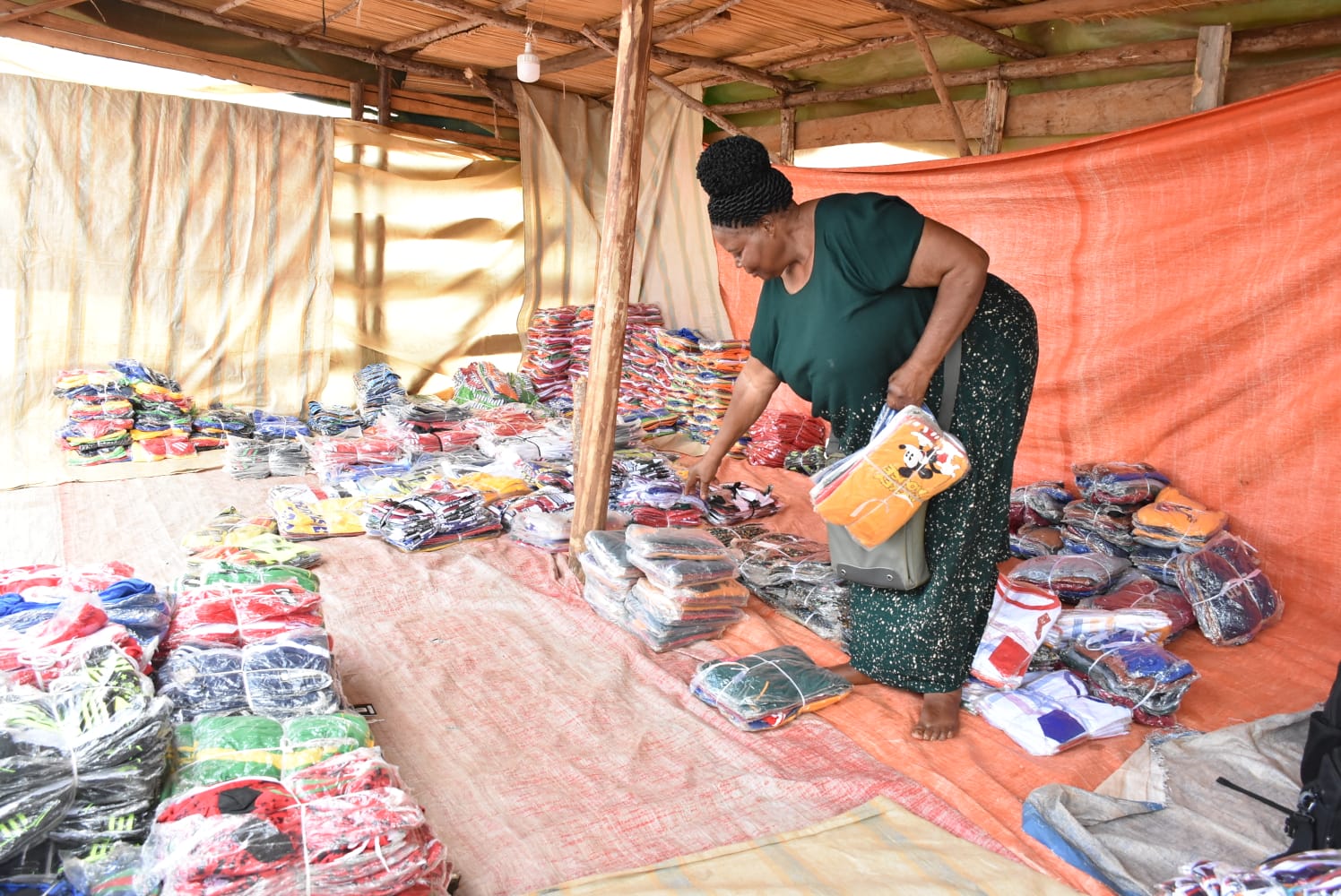
Many women say the system is safe and efficient, and has allowed them to get nutritious foods from Kenya, while also supplying the same from Uganda.
“We also supply eggs to Kenya. I know it is helping families a lot to build their nutrition,” Mary says.
The Kenya Agricultural and Livestock Research Organisation says eggs contain about 6.5 grammes of protein, providing nine essential amino acids necessary for maintaining good human health.
This explains the significant impact the movement of foodstuffs is having for families in Kenya.
Apart from foodstuffs, Kenyan traders like Rosebella Akoth, better known as Mama Rose, have built thriving businesses and support systems alongside their Ugandan counterparts.
Once a second-hand clothes seller, she now sells readymade garments, mostly to Ugandan customers.
“Ugandans buy in bulk,” she says, adding that most Ugandan traders prefer to buy the clothes in Kenya.
Mama Rose, who began trading in 1985, leads a women's table banking group now as Soko Hewani Women's Group.
Through this group, they also share information on how to fight malnutrition through foodstuffs sold through cross-border trade.
“Our group has 59 members and we have grown our capital to Sh1.3 million,” she says, adding that last year, they made a huge profit from the amount they give members and loans that are later refunded with profits.
Busia Fish Market chairman Boniface Osogo says they normally deal with fish from Uganda, when they come in while still fresh, smoked or sun-dried.
They also deal with fish from Lake Turkana, which is transported to DRC, Uganda and other parts of East Africa.
He says women and youth are the major traders here and contribute a lot to nutrition supply. Most of the fish from Uganda brought by the migrants are fresh from the lake and always nutritious.
“We export almost 80 to 90 tonnes of fish to DRC each week. That is between Sh100 and Sh200 million turnover per month,” Boniface says.
He acknowledges the daily presence of more than 100 Ugandan women, who are helping to bridge the gap of food shortage by supplying farm produce to Kenya.
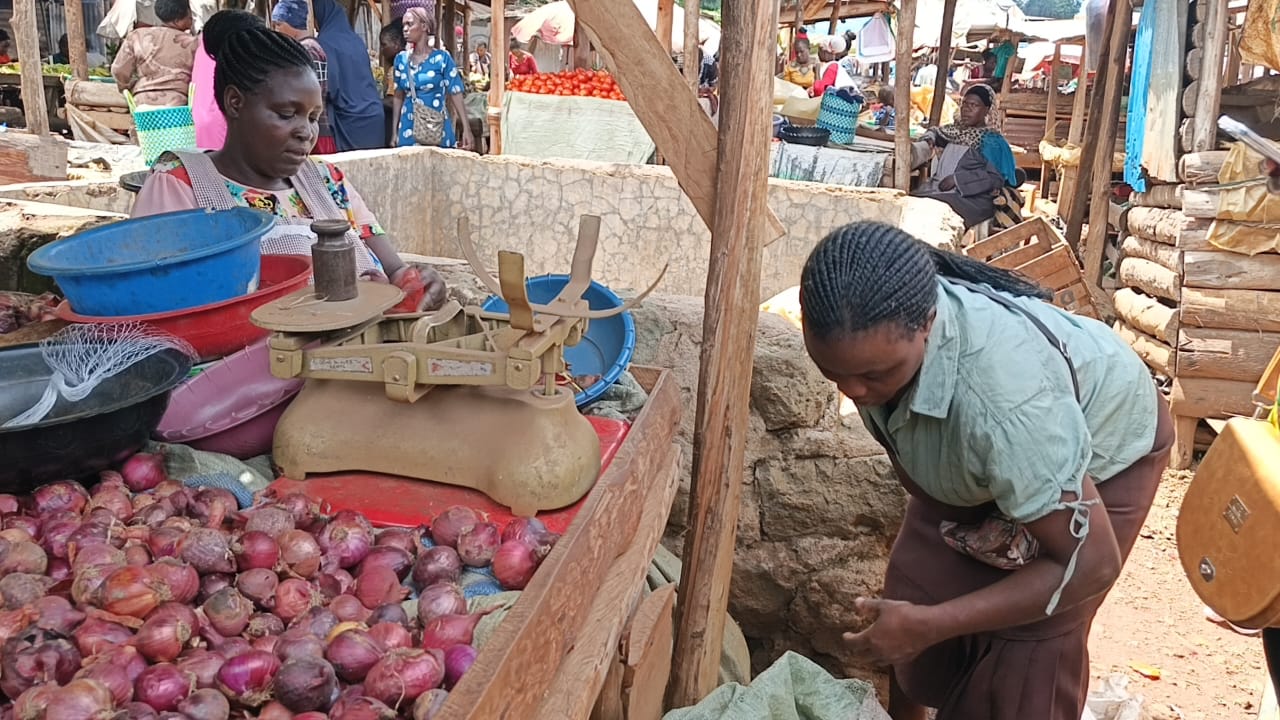
CALL TO ACTION
Nutritionists says that while cross-border trade improves income for many women, nutritionists warn that this does not always lead to better family nutrition. The main gap lies in knowledge as many traders don’t understand which foods are nutritious.
She shares that some women sell all their eggs, then buy mandazi and strong tea for their children, missing essential nutrients.
She emphasises the need to empower traders with information on nutritious foods not just for selling but for feeding their families. Bridging this knowledge gap is crucial to turning economic gains into better health and ending the cycle of hidden hunger.
As the sun dips behind the skyline of Busia, the market winds down, but the work of these women is far from over. With every basket of bananas, every bundle of fish and every handful of vegetables sold, they are weaving the fabric of a future where food security is not a privilege but a shared reality.
These women are more than just traders. They are unsung architects of regional unity, the quiet warriors fighting malnutrition one meal at a time, and the backbone of East Africa’s evolving economy.
Thanks to the freedom of movement across borders, these women navigate seamlessly between Uganda and Kenya, turning border towns into bridges of opportunity rather than barriers.
Free movement does not just support livelihoods, it sustains families, strengthens markets and nourishes entire communities.
In a region grappling with chronic food insecurity, these women stand as living proof that when trade is unhindered and people are free to move, local solutions become powerful engines of change.
This content is produced as part of the Move Africa project, commissioned by the African Union Commission and supported by the Deutsche Gesellschaft für Internationale Zusammenarbeit (GIZ) GmbH. The views and opinions expressed are those of the authors only and do not necessarily reflect those of the GIZ or the African Union











